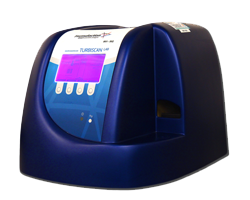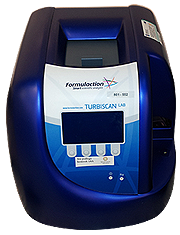 We study the stability of the liquid dispersion (emulsions, suspensions, foams) using Turbiscan Lab (Formulation). Multiple light scattering technique is applied in the analyzer. The measurement consists on scanning the sample vertically along the source of near-infrared light. The results are collected by two detectors:
We study the stability of the liquid dispersion (emulsions, suspensions, foams) using Turbiscan Lab (Formulation). Multiple light scattering technique is applied in the analyzer. The measurement consists on scanning the sample vertically along the source of near-infrared light. The results are collected by two detectors:
- transmission detector
- backscattering detector
Measurements conducted over time, which record changes the intensity of transmitted light and backscattering light, shows the stability profile of the test sample. Stability profile is the dependence of the intensity of backscattered light and the intensity of transmitted light on the height of the sample in a function of time. During the measurement are detected such processes as sedimentation, cream, agglomeration, aggregation, flocculation, coalescence, phase separation, etc ..
The collected measurement results allow calculation of:
- parameter TSI (Turbiscan Stability Index), which sets global stability of samples and allows for characterization of stability and comparison of samples.
- kinetics changes occurring destabilization phenomena
- changes in the average diameter and the concentration of particles occurs during the aging of the sample.
For more information please contact our testing services representatives.
 Turbiscan measures suspensions stability using a moving reading head composed of an NIR light source with a transmission and backscatter detector. The reading head scans a sample by moving vertically along the analysis cell and taking data every 40 microns. By making these measurements over time, changes in the backscatter and transmission levels due to sample instability are recorded. These changes indicate particle migration in the sample (settling and creaming) as well as particle size change.
Turbiscan measures suspensions stability using a moving reading head composed of an NIR light source with a transmission and backscatter detector. The reading head scans a sample by moving vertically along the analysis cell and taking data every 40 microns. By making these measurements over time, changes in the backscatter and transmission levels due to sample instability are recorded. These changes indicate particle migration in the sample (settling and creaming) as well as particle size change.
The backscattering and transmission levels depend on 3 parameters:
- Particle size
- Particle concentration
- Refractive indices of both phases
